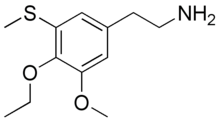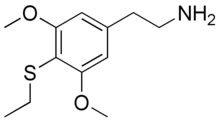
PiHKAL: A Chemical Love Story is a book by Dr. Alexander Shulgin and Ann Shulgin, published in 1991. The subject of the work is psychoactive phenethylamine chemical derivatives, notably those that act as psychedelics and/or empathogen-entactogens. The main title, PiHKAL, is an acronym that stands for "Phenethylamines I Have Known and Loved".

2,5-Dimethoxy-4-ethylamphetamine is a psychedelic drug of the phenethylamine and amphetamine chemical classes. It was first synthesized by Alexander Shulgin, and was described in his book PiHKAL.
Ganesha (2,5-dimethoxy-3,4-dimethylamphetamine) is a lesser-known psychedelic drug. It is also a substituted amphetamine. It was first synthesized by Alexander Shulgin. In his book PiHKAL, the dosage range is listed as 24–32 mg. The drug is usually taken orally, although other routes such as rectally may also be used. Ganesha is synthesized from 2,5-dimethoxy-3,4-dimethylbenzaldehyde. Ganesha is the amphetamine analog of 2C-G. It is a particularly long lasting drug, with the duration listed in PiHKAL as being 18–24 hours, which might make it undesirable to some users. It is named after the Hindu deity, Ganesha. Very little is known about the dangers or toxicity of ganesha. Effects of ganesha include:

3,4-Methylenedioxy-N-hydroxyamphetamine is an entactogen, psychedelic, and stimulant of the phenethylamine and amphetamine chemical classes. It is the N-hydroxy homologue of MDA, and the N-desmethyl homologue of MDHMA. MDOH was first synthesized and assayed by Alexander Shulgin. In his book PiHKAL, Shulgin listed the dosage range as 100–160 mg, and the duration as approximately 3–6 hours. He describes MDOH as being very psychedelic and producing increased pleasure in beauty and nature. He also mentioned several negative side effects also seen with MDMA ("Ecstasy") such as difficulty urinating and internal dryness.
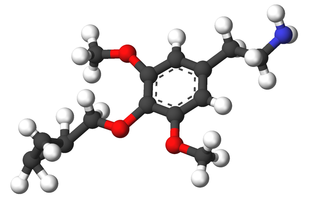
Cyclopropylmescaline is a lesser-known psychedelic drug. CPM was first synthesized by Alexander Shulgin. In his book PiHKAL, the dosage range is listed as 60–80 mg and the duration listed as 12–18 hours. CPM produces closed-eye imagery, visuals, and fantasies. It also causes enhancement of music. Very little data exists about the pharmacological properties, metabolism, and toxicity of CPM.
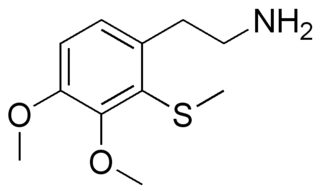
TIM, or thioisomescaline, is a series of lesser-known psychedelic drugs similar in structure to mescaline. They were first synthesized by Alexander Shulgin. In his book PiHKAL , none of their durations are known. Very little is known about their dangers or toxicity.
TASB, or thioasymbescaline, is a series of lesser-known psychedelic drugs similar in structure to asymbescaline and to mescaline. They were first synthesized by Alexander Shulgin and written up in his book PiHKAL . Very little is known about their dangers or toxicity.
TME, or thiometaescaline, is a series of lesser-known psychedelic drugs similar in structure to mescaline. Their structures are based on that of metaescaline. They were first synthesized by Alexander Shulgin and recorded in his book PiHKAL . Very little is known about their dangers or toxicity.

3,4-Methylenedioxy-N-hydroxy-N-methylamphetamine is an entactogen, psychedelic, and stimulant of the phenethylamine and amphetamine chemical classes. It is the N-hydroxy homologue of MDMA ("Ecstasy"), and the N-methyl homologue of MDOH. MDHMA was first synthesized and assayed by Alexander Shulgin. In his book PiHKAL, Shulgin listed the dosage range as 100–160 mg, and the duration as approximately 4–8 hours. He describes MDHMA as causing entactogenic and open MDMA-like effects, easing communication, and increasing appreciation of the senses.

Beatrice is a lesser-known psychedelic drug. It is a substituted methamphetamine and a homolog of 2,5-dimethoxy-4-methylamphetamine (DOM). Beatrice was first synthesized by Alexander Shulgin. In his book PiHKAL, the minimum dosage is listed as 30 mg, and the duration listed as 6–10 hours. Beatrice produces a vague feeling of openness and receptiveness, and causes a stimulative effect. It also causes diarrhea. Very little data exists about the pharmacological properties, metabolism, and toxicity of beatrice.

BOD (4-methyl-2,5,β-trimethoxyphenethylamine) is a lesser-known psychedelic drug. It is the beta-methoxy analog of 2C-D. BOD was first synthesized by Alexander Shulgin. In his book PiHKAL, the dosage range is listed as 15–25 mg, and the duration listed as 8–16 hours. BOD produces strongly distorted open-eye visuals, and some closed-eye visuals. It also has an entheogenic effect and produces humor. Very little data exists about the pharmacological properties, metabolism, and toxicity of BOD.
Thiomescaline (TM) is a pair of lesser-known psychedelic drugs with the molecular formula C11H17NO2S. 3-TM and 4-TM are analogs of mescaline in which an oxygen atom has been replaced with a sulfur atom. They were first synthesized by Alexander Shulgin and described in his book PiHKAL. Very little data exists on the pharmacological properties, metabolism, and toxicity of thiomescaline.
TOM, or methylthio-methyl-methoxyamphetamine, is a series of lesser-known psychedelic drugs and substituted amphetamines with the molecular formula C12H19NOS. 2-TOM and 5-TOM are the 2- and 5-methylthio analogs of 2,5-dimethoxy-4-methylamphetamine (DOM), respectively. They were first synthesized by Alexander Shulgin and described in his book PiHKAL. Very little is known about their dangers or toxicity.
TOET (methylthio-ethyl-methoxyamphetamines) is a pair of lesser-known psychedelic drugs and substituted amphetamines. 2-TOET and 5-TOET are the 2- and 5-methylthio analogs of DOET, respectively. They were first synthesized by Alexander Shulgin and written up in his book PiHKAL. Very little is known about their dangers or toxicity.

TSB, or thiosymbescaline, is a series of lesser-known psychedelic drugs similar in structure to symbescaline. They were first synthesized by Alexander Shulgin and written up in his book PiHKAL . Very little is known about their dangers or toxicity.
Thiotrisescaline (T-TRIS) is a series of lesser-known phenethylamines prepared as potential psychedelic drugs. There are two isomers, 3-T-TRIS and 4-T-TRIS, each similar in structure to trisescaline with a sulfur atom in a place of a different oxygen atom. They were first synthesized by Alexander Shulgin and described in his book PiHKAL. Very little is known about their dangers or toxicity.
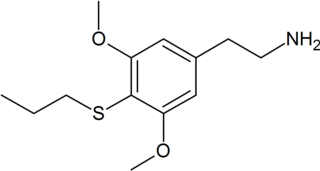
Thioproscaline, or 3,5-dimethoxy-4-propylthiophenethylamine, is a lesser-known psychedelic drug. It is the 4-propylthio analog of mescaline. Thioproscaline was first synthesized by Alexander Shulgin. In his book PiHKAL , the dosage range is listed as 20–25 mg, and the duration listed as 10–15 hours. Thioproscaline causes closed-eye visuals, slight open-eye visuals, and a body load. Very little data exists about the pharmacological properties, metabolism, and toxicity of thioproscaline.

MEPEA, or 3-methoxy-4-ethoxyphenethylamine, is a lesser-known psychedelic drug. MEPEA was first synthesized by Alexander Shulgin. In his book PiHKAL , the minimum dosage is listed as 300 mg, and the duration unknown. MEPEA produces a light lifting feeling and a +1 on the Shulgin Rating Scale. Very little data exists about the pharmacological properties, metabolism, and toxicity of MEPEA.
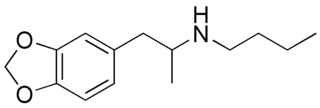
Methylenedioxybutylamphetamine is a lesser-known psychedelic drug. It is also the N-butyl derivative of 3,4-methylenedioxyamphetamine (MDA). MDBU was first synthesized by Alexander Shulgin. In his book PiHKAL, the minimum dosage is listed as 40 mg, and the duration unknown. MDBU produces few to no effects. Very little data exists about the pharmacological properties, metabolism, and toxicity of MDBU.

2C-Se is a lesser-known psychedelic drug. It was originally named by Alexander Shulgin as described in his book PiHKAL. Shulgin considered 2C-Se to be around three times the potency of mescaline, but was too concerned about toxicity to test it extensively, though he considered it noteworthy as the only psychedelic drug to contain a selenium atom.
